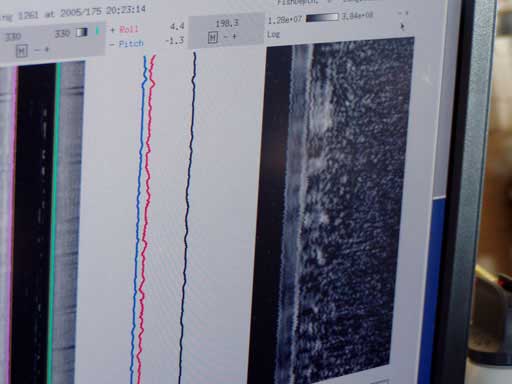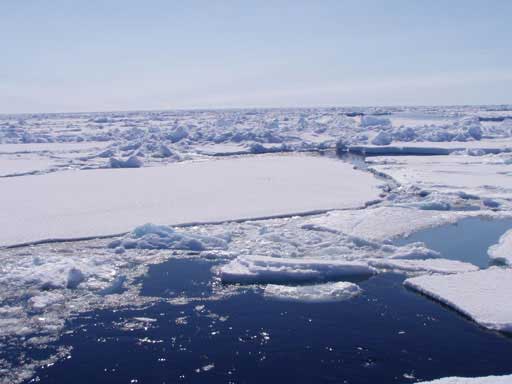( Log In ) Log In is for TREC Teachers & Researchers only
  |
| Steve_Marshall |
 Jun 26 2005, 01:26 AM Jun 26 2005, 01:26 AM
Post
#1
|
 TREC Teacher    Group: TREC Team Posts: 78 Joined: 27-April 05 Member No.: 12 |
Friday 6/24/05
CRUISE IS WINDING DOWN, BUT THE SCIENCE IS STILL GOING STRONG The comic relief for the day came VERY early in the morning. I had been up late and probably only had about two hours sleep before I was abruptly awakened. One of the guys I am sharing the room with, Brian Meeks, had been trading shifts with two other students who were in charge of watching the sonar monitors so that at least one person was watching the data at all times. Occasionally, he would also have to get up at strange hours if we were getting ready to do a plankton tow because he was one of the plankton researcher’s students (When science calls...). Anyway, one of the other student interns, Ray Savicke, and Brian often joked around with each other. I guess when Ray was asked to wake up Brian for a plankton tow or whatever reason, he was going to make the most of it and do it right. So, Ray came in our room around 5:00 am and started pounding and knocking and yelling at Brian to get up, and using some creative words while he was doing it. The only problem was that this wasn’t being done to Brian, it was being done to ME! Because the room was so dark, Ray had mistaken me for Brian. When he realized it was me, he burst into laughter at my expression and reaction to this unusual wake-up call. I have to admit, I did have one of those, “Where am I, what day is it, what is going on, and WHY is this person shaking me and yelling at me to get up?” type of moments you get when woken up from a deep sleep. I had been so tired, though, it didn’t take long for me to fall back to sleep, but we did joke and laugh about it a lot throughout the day. I kept asking Ray, since he had been pulling some late shifts too, if he was tired and going to take a nap, in a way that insinuated I was going to find some way to get him back the next time he went to sleep. I never did, but making him worry about it some was good enough. Anyway, when the REAL morning started, it was back to work. Another CTD profile was taken at the new location we had arrived at overnight. Sometime later, the ice conditions, our position, and the timing of other conditions were all such that we were able to put the IMI in the water for the first time of the cruise…I guess some is better than none. The IMI is a multibeam imaging system that provides very good and detailed information about the seafloor and the subsurface. It is similar in purpose to the sonar and other information we were using, but with much more resolution. If we had been able to use this more during the cruise, we probably would have been able to be more precise in choosing our coring locations. Even so, it was interesting to see the information provided by this instrument even if it was for a short amount of time. This instrument was operated by the mapping group from Hawaii, so it was nice to see have a chance to use it because even though they have been busy with the other seismic data during this trip, I know the IMI is the one thing they would have liked to work with as much as possible. The Pride of the Hawaii Group  This is a picture of the IMI as it does its thing in the Arctic Ocean Keeping Watch  The chief scientist of the Hawaii group, Margo Edwards, and Louis Whitcomb from Johns Hopkins shown on the back of the ship as they monitor the position of IMI Monitoring the Data  Val Schmidt, Paul Johnson, and Steve Roberts view the data coming in from the IMI IMI’s Output  From left to right, IMI shows a sidescan image, bottom detector, the amount of roll and pitch of the instrument, the heading, and the subbottom profile. Close Up of the Subbottom  If you look at the black and white column to the right on the monitor screen, you can see some wavy lines. Those wavy lines indicated different sediment layers beneath the seafloor (note the seafloor image is rotated 90 degrees from horizontal). Another Set of Eyes  Mark Rognstad (seated) joins Paul Johnson, both from the University of Hawaii’s Mapping Research Group, in reviewing the data from the IMI. After getting an hour or so of data, the IMI was brought back up to clear the way for the next operation of the day…Another helicopter flight to look for dirty sea-ice. Since the working decks must be cleared for a certain amount of time before and after the helicopter takes off, to be a little more efficient with our time, we also put another piston core in the water just before the takeoff. This way, the core could be on its way down, a process that can be done remotely, while the decks had to be clear. Then, once the helicopter got back, the core would be ready to be lifted out. With this efficient juggling of operations, the result was a successful helicopter flight with the collection of some sediment in the ice, but a not-so-successful core. Only about a third of the core was filled, but again, any sediment can still be used for research. Seeing Something in a Different Way  I took this picture during my observation of the coring operations. It was ironic that I had just finished explaining on the TREC website that even though the scenery here doesn’t change a lot, you can still view the same thing in different ways. It was ironic, because this picture ended up being an example of just that; While I was taking this shot of pressure ridges in the ice that I had seen so many times before, it occurred to me at that point that the movement of ice, and the resulting pressure ridges, probably serves as a fairly good model of plate tectonics on a smaller scale. The busy schedule was maintained by sending down multi-core #6 soon after the piston core was retrieved. The success of the multi-core was more than the piston core, with almost a full load of sediment in each core tube. Once again, the core-extruding team went into action and each researcher did their regular routine on the samples. By the time these experiments were completed, we found ourselves already at dinner time again. After dinner, Joseph Ortiz was the speaker of the evening, giving a talk about his research using light reflectance studies of sediment cores and how this provides information about climate events such as El Nino and La Nina. After the talk, we had a short meeting discussing our last full day on the ship. Planning to do one more piston core, multi-core, plankton tow, and possibly a CTD profile, along with the responsibilities of having to begin packing and cleaning the lab spaces and our rooms meant the last full day on the ship was definitely going to be a FULL day. |
  |
2 User(s) are reading this topic (2 Guests and 0 Anonymous Users)
0 Members:

|
NSF Acknowledgment & Disclaimer | Time is now: 5th November 2024 - 04:36 PM |
Invision Power Board
v2.1.7 © 2024 IPS, Inc.








